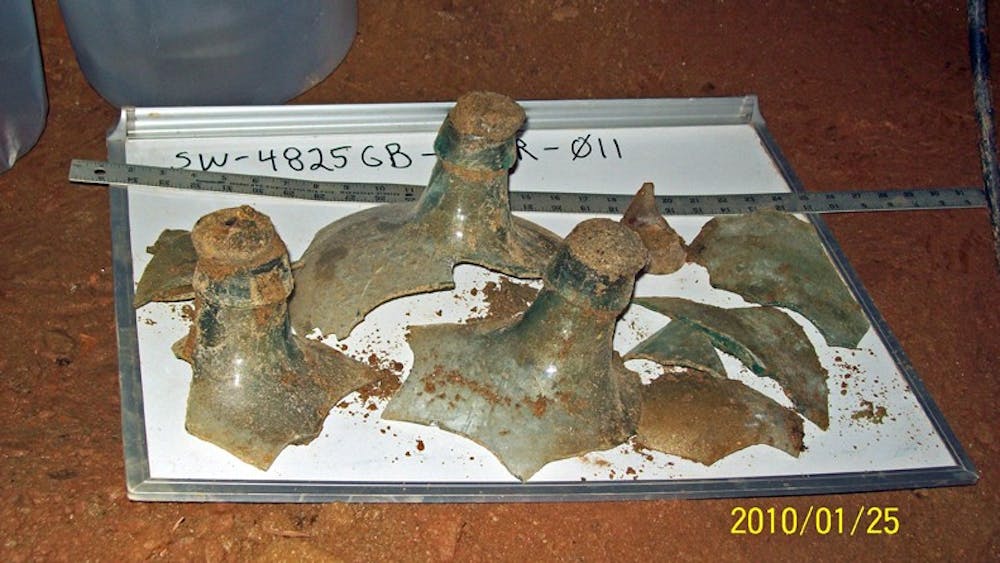The Army Corps of Engineers unearthed three broken glass jugs on Monday, Jan. 25 at their “Pit 3” investigation at 4825 Glenbrook Rd. N.W., a Corps spokesman told The Eagle.
The find has generated questions as to whether a long sought-after munitions cache, known as the “Sgt. Maurer burial pit,” has finally been located.
An environmental specialist for the District Department of the Environment’s Toxic Substance division, Dr. Richard Albright, told The Eagle that rumors of the munitions cache have been based on aerial photography and World War I-era photos depicting Army Sergeant C. W. Maurer standing amid approximately 30 glass jugs similar to the ones found last Monday and possibly filled with the chemical agent mustard.
A hand-written caption on the back of one of the photos identifies the pictured jugs to be filled with “mustard.” Maurer wrote that he was burying the jugs in “Death Valley,” in this “hole called Hades,” according to Albright.
Albright said nine or 10 photos exist in all, some of which show sheds in the background that are known to have been used as toxic chemical storage facilities.
When Albright and a colleague from the Environmental Photographic Interpretation Center obtained copies of Sgt. Maurer’s photos in 1997, they analyzed them along with old aerial photography and determined the pit’s location to be somewhere within the 4825 Glenbrook Rd. N.W. property.
This analysis played a central role in convincing the Army Corps to pursue further investigations in Spring Valley, Albright said.
Corps spokesman Clem Gaines said he could not speculate if the recent find was actually part of a larger cache.
“The answer is we really don’t know,” he said. “We could have [found it], or it could have been someplace else.”
An initial analysis revealed no chemical traces on the jugs, which will be treated as normal glassware debris, according to Gaines.
“We have always said that attempting to name a pit the ‘Sgt. Maurer pit’ is a difficult task,” he added. “It could be Pit 1, 2 or 3, or it could be a pit that over the years has been demolished by all the development in the Glenbrook Road area.”
Pits 1 and 2 refer to past Army Corps investigations at 4801 Glenbrook Rd. N.W. — across the street from the 4825 property.
But Albright believes that during World War I, the Army used the area as a larger disposal pit for laboratory and munitions debris rather than just a pit for the glass jugs, and that most of the debris has not been found.
“I don’t think they got hauled away,” he said. “I think that the bulk of that pit [the workers] didn’t get to.”
He said it is likely the construction workers who erected the building at 4825 Glenbrook Rd. ran into World War I-era glassware but reburied it underneath or beside the house’s foundation.
“They probably buried them in the deepest part of the pit,” he said, adding that while it is possible the contractors hauled away all the glassware they recovered, it is highly unlikely.
“I kind of think that quantity would’ve caused some real serious problems,” he said. “Some worker somewhere would’ve been overcome, and you’d have dead bodies following the truck.”
Over the course of their Pit 3 investigation, the Corps has found debris ranging from harmless glassware to intact bottles filled with mustard agent and lewisite.
“When we do our operations, we want to find these materials,” Gaines said. “We expect to find debris, and our mission is to investigate, remediate and remove or clean up any debris left over from [Department of Defense] activities.”
Albright conveyed his sympathies to AU, which volunteered its campus to be used as an experimental station for the Army’s Chemical Corps during World War I.
“They tried to do the patriotic thing in 1917, and now I’m sure they’re still ruing that decision,” he said.
You can reach this staff writer at ccottrell@theeagleonline.com.





